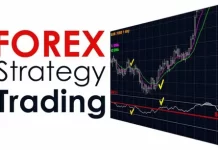When you plan to engage in forex trading, you will come across several terms, but the most prominent term you would hear and focus on is the ‘Spreads’, which is the difference between the bid and ask price of a currency pair. However, many traders don’t know the relevance of spreads in the trading process and the impact spreads have on the trading results. This write-up will cover all the relevant information about spreads and how to easily calculate them using advanced trading tools so that you can get into trading without any confusion and move closer to your trading goals.
What Are Forex Spreads?
When you become a forex trader, you will buy and sell international currencies formed into pairs to represent the exchange rate. In other words, you will place trades anticipating an increase or decrease in the exchange rate or the price of the chosen currency pair. Now, there are 2 different prices: bid price, which means the price for buying a pair, and ask price, which is the price for selling the same pair. The difference in the bid and ask prices is called spreads in forex terms.
This difference in bid and ask prices is actually the spread charged by your broker for earning revenue from the orders placed by their clients. You can think of spreads as a form of markup on the prices of currency pairs, which becomes the profit margin for brokers. Each currency pair will have different spreads based on their trading volume. Less liquid currency pairs will always have higher spreads in comparison.
Major currency pairs always have the lowest spreads as they have the highest volume of trade, and the EUR/USD pair is an apt example. Most brokers will mention the spreads as a part of the trading conditions offered, and they always state the spreads charged for EUR/USD as spreads starting from, as this is the lowest or minimum amount of spread you need to pay for trading on their platform.
Calculation of Forex Spread and Cost of Trading
Spreads and commissions are 2 types of costs that you need to consider while choosing your broker. Calculation of the spreads that you will be paying for a trade is essential to estimate the trading cost incurred with a broker. Most brokers state the spreads charged in pips to make it comprehensive for traders as they use pips as the standard unit of measurement for all trading activities.
Pip value is the most basic forex concept you need to understand as a beginner in the currency market. Brokers will state the spreads charged in pips; hence, you should also know about pip value calculation. Those who are still learning about pip value can take the help of online tools like automated pip calculators, which come in handy for grasping the concept of pips.
Since spreads are the difference between the bid and ask price, you can use these two values to calculate spreads. Suppose you get to buy the EUR/USD pair at 1.11114, which is the high price here, and when you sell the pair, the ask price is 1.11112. So, you just have to deduct the ask price from the bid price, and the answer you get will be the spreads charged on the pair. And in this case, the spreads will only be 0.00002 or 2 pips.
Now, you also need to consider the size of your trade position as total spreads or the cost of trading will be estimated based on trade size in lots. If you are trading with 1 standard lot, there will be 1,00,000 currency units being traded, and then you can find the monetary value of spreads, which will be reflected on your account as a deduction following the trade.
Here, it will be done like 0.00002* 1,00,000, which makes the actual spreads add up to $2 for the trade, which is comparatively low. In this example, we have taken USD as the base currency, but you need to calculate the spreads in the currency with which you have funded your account. If you have chosen the Euro as the base currency, you should do all calculations in Euro to make things easier for yourself.
What Difference Can a High Spread and a Low Spread Make to Your Trading?
The spreads charged can go up or down depending on several factors. We already mentioned that the trade volume influences spread as the most liquid currency pairs have lower spreads than other less liquid pairs. But volatility also plays a part in determining spreads in live trading. You will also see the spreads on the low side during major trading sessions and higher during the less busy market hours.
Now, you can see the spreads directly impacting your trading cost and your trading results or account balance after the closure of a trade. Your trades end up in profit when you can cover the cost of trading in the first place while making some gains. So, tight spreads or narrow spreads surely increase your profit potential as you just have to cover a small amount from your profits.
So, understanding spread also allows you to calculate the potential profits for your trades more precisely. If you know the spreads you have earned in a certain trade, then using a profit calculator, you can easily determine the exact profit you have made in your own currency, saving you from tedious calculations.
You can also find simple forex spread calculators that are freely available online, but you need to choose the best one for getting accurate results. Using such basic tools makes the calculation process and trading process way easier for everyone as you can save a lot of time and get things done with minimal effort while eliminating errors that can happen when you calculate it manually.
The trading conditions offered by the broker also include the difference between the bid and ask prices. The wider this difference gets, the higher the spread gets; when this difference is smaller, the spreads will also be lower. Choosing a low-spread broker allows you to trade at a minimum cost. However, the commission charged by the broker will also form a part of the trading cost, and you need to consider both while trading.
Why Do Spreads Change So Often?
The forex market is very unpredictable at times, especially when a news event affects the financial markets and currency prices. The market experiences sudden volatility before or during the release of news. The volatility will remain until the news effect subsides from the market or the currency pairs stop reacting to the news. The overall market sentiments also have a role to play in this volatility. As mentioned earlier, the spreads on volatile currency pairs are always higher than those charged for trading less volatile ones.
The spreads can widen during news events as the liquidity providers try to bring down their risk by adjusting the spreads. Liquidity providers are people in charge of maintaining the trade volume at a level where retail traders get sufficient liquidity to place trades at the best prices. But when there is high volatility, the outcome will be unpredictable for all market participants, which makes the liquidity providers higher the spreads to stay on the safer side in case the market becomes unfavourable as an after-effect of the news.
Another thing that can happen in such a situation is slippage. Slippage is quite common during volatile hours, especially if the trading volume decreases. Most traders try to stay out of the market when the volatility takes unpredictable turns, as they simply don’t want to take uncalculated risks.
So, when there is a lack of trade volume and high volatility, the liquidity providers will also have a hard time providing fast execution of orders, and hence, your orders will get executed at a different price than what you quoted. Slippage is an annoying thing to deal with for all of us, and in order to avoid this situation, you must keep an eye on the spreads as if the spreads get wider during volatile hours, the chances of slippage also get high.
Final Thoughts
Spreads play a key role in the trading process and also impact your trading results. Calculation of spreads and keeping them out of the potential profits is essential to get the best possible trading results.








